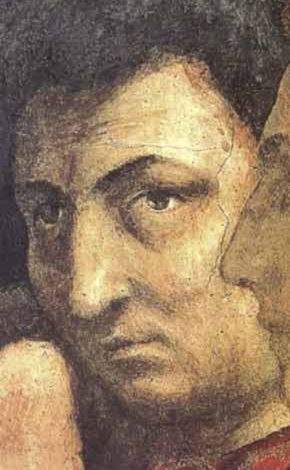
Masaccio, born Tommaso di Ser Giovanni di Simone, was a Florentine artist who is regarded as the first great Italian painter of the Quattrocento period of the Italian Renaissance. According to Vasari, Masaccio was the best painter of his generation because of his skill at imitating nature, recreating lifelike figures and movements as well as a convincing sense of three-dimensionality. He employed nudes and foreshortenings in his figures. This had seldom been done before him.
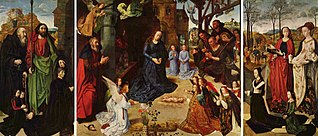
The Portinari Altarpiece or Portinari Triptych is an oil-on-wood triptych painting by the Flemish painter Hugo van der Goes, commissioned by Tommaso Portinari, representing the Adoration of the Shepherds. It measures 253 x 304 cm, and is now in the Galleria degli Uffizi in Florence, Italy. This altarpiece is filled with figures and religious symbols. Of all the late-fifteenth-century Flemish artworks, this painting is said to be the most studied.

The Descent from the Cross is the central panel of a triptych painting by the Baroque artist Peter Paul Rubens in 1612–1614. It is still in its original place, the Cathedral of Our Lady, Antwerp, Belgium. The painting is considered to be one of Rubens' masterpieces. The painting depicts the moment when the body of Jesus Christ is taken down from the cross after his crucifixion. The subject was one Rubens returned to again and again in his career. The artwork was commissioned on September 7, 1611, by the Confraternity of the Arquebusiers, whose patron saint was St. Christopher.
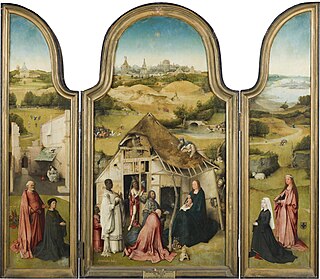
The Adoration of the Magi or The Epiphany is a triptych oil painting on wood panel by the Netherlandish artist Hieronymus Bosch, executed around 1485–1500. It is now in the Museo del Prado in Madrid, Spain.

The Master of the Morrison Triptych is the name given to an unknown Early Netherlandish painter active in Antwerp around 1500-1510. He is named for the Morrison Triptych, now in Toledo, Ohio, United States, which is described below.
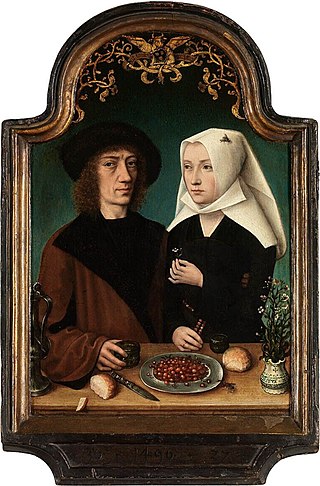
The Master of Frankfurt was a Flemish Renaissance painter active in Antwerp between about 1480 and 1520. Although he probably never visited Frankfurt am Main, his name derives from two paintings commissioned from patrons in that city, the Holy Kinship in the Frankfurt Historical Museum and a Crucifixion in the Städel museum.
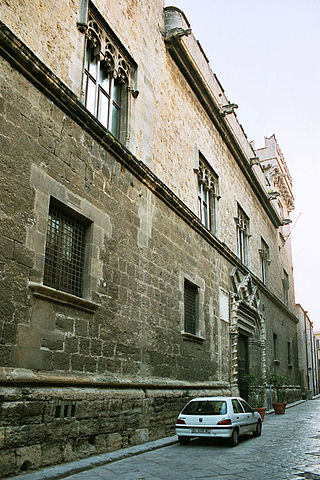
Palazzo Abatellis is a palazzo in Palermo, Sicily, southern Italy, located in the Kalsa quarter. It is home to the Galleria Regionale della Sicilia, the Gallery of Art for the Sicilian region.
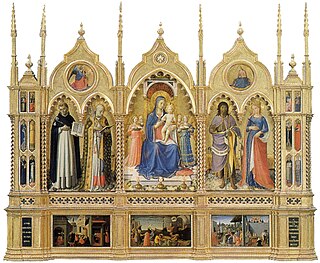
The Perugia Altarpiece is a painting by the Italian early Renaissance painter Fra Angelico, housed in the Galleria Nazionale dell'Umbria of Perugia, Italy.

The Braque Triptych is a c. 1452 oil-on-oak altarpiece by the Early Netherlandish painter Rogier van der Weyden. When open, its three half-length panels reveal, from left to right, John the Baptist, The Virgin Mary with Jesus and Saint John the Evangelist, and on the right, Mary Magdalene. When the wings are closed, the work shows a vanitas motif of a skull and cross.

The Annunciation with St. Margaret and St. Ansanus is a painting by the Italian Gothic artists Simone Martini and Lippo Memmi, now housed in the Uffizi Gallery in Florence, Italy. It is a wooden triptych painted in tempera and gold, with a central panel having double size. Considered Martini's masterwork and one of the most outstanding works of Gothic painting, the work was originally painted for a side altar in the Siena Cathedral.
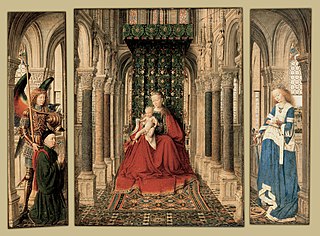
The Dresden Triptych is a very small hinged-triptych altarpiece by the Early Netherlandish painter Jan van Eyck. It consists of five individual panel paintings: a central inner panel, and two double-sided wings. It is signed and dated 1437, and in a permanent collection of the Gemäldegalerie Alte Meister, Dresden, with the panels still in their original frames. The only extant triptych attributed to van Eyck, and the only non-portrait signed with his personal motto, ALC IXH XAN, the triptych can be placed at the midpoint of his known works. It echoes a number of the motifs of his earlier works while marking an advancement in his ability in handling depth of space, and establishes iconographic elements of Marian portraiture that were to become widespread by the latter half of the 15th century. Elisabeth Dhanens describes it as "the most charming, delicate and appealing work by Jan van Eyck that has survived".

Virgin and Child is a small c. 1485–1490 double hinged oil on oak triptych with a central panel by a follower or workshop member of the Flemish painter Hugo van der Goes or Gerard David. The work is currently held in the National Gallery, London with the central panel in its original frame. The central image is a tightly cropped and intimate portrayal Mary cradling the infant Jesus, who plays with a red rosary tied around his neck.

The Virgin and Child with Canon van der Paele is a large oil-on-oak panel painting completed around 1434–1436 by the Early Netherlandish painter Jan van Eyck. It shows the painting's donor, Joris van der Paele, within an apparition of saints. The Virgin Mary is enthroned at the centre of the semicircular space, which most likely represents a church interior, with the Christ Child on her lap. St. Donatian stands to her right, Saint George—the donor's name saint—to her left. The panel was commissioned by van der Paele as an altarpiece. He was then a wealthy clergyman from Bruges, but elderly and gravely ill, and intended the work as his memorial.
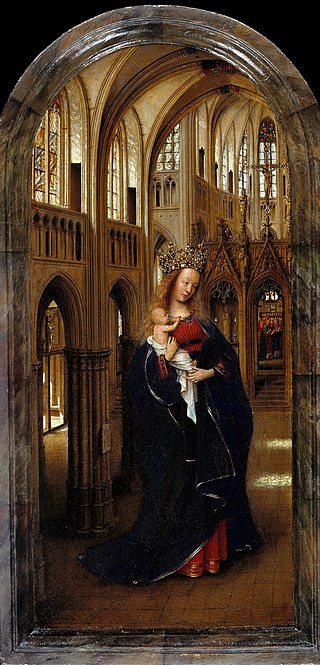
Madonna in the Church is a small oil panel by the early Netherlandish painter Jan van Eyck. Probably executed between c. 1438–1440, it depicts the Virgin Mary holding the Child Jesus in a Gothic cathedral. Mary is presented as Queen of Heaven wearing a jewel-studded crown, cradling a playful child Christ who gazes at her and grips the neckline of her red dress in a manner that recalls the 13th-century Byzantine tradition of the Eleusa icon. Tracery in the arch at the rear of the nave contains wooden carvings depicting episodes from Mary's life, while a faux bois sculpture in a niche shows her holding the child in a similar pose. Erwin Panofsky sees the painting composed as if the main figures in the panel are intended to be the sculptures come to life. In a doorway to the right, two angels sing psalms from a hymn book. Like other Byzantine depictions of the Madonna, van Eyck depicts a monumental Mary, unrealistically large compared to her surroundings. The panel contains closely observed beams of light flooding through the cathedral's windows. It illuminates the interior before culminating in two pools on the floor. The light has symbolic significance, alluding simultaneously to Mary's virginal purity and God's ethereal presence.

The Dresden Altarpiece is a triptych by the German Renaissance artist Albrecht Dürer, executed between 1496 and 1497, and perhaps continued in 1503–1504. It is housed in the Gemäldegalerie Alte Meister of Dresden, Germany.

The Monforte Altarpiece is an oil-on-oak-panel painting of the Adoration of the Magi by the Flemish painter Hugo van der Goes, now in the Gemäldegalerie, Berlin, Germany. The altarpiece was originally the central panel of a triptych with movable wings that are now lost; these were probably painted on both sides. This is shown by the hinges remaining in the original frame. Old copies of the work show the Nativity and Circumcision of Jesus on the wing panels. The central panel has been reduced in size at the top.

San Gregorio Polyptych is a tempera-on-wood polyptych painting by the Italian Renaissance master Antonello da Messina, completed in 1473 and housed in the Regional Museum of Messina, Italy.

The St John Altarpiece is a large oil-on-oak hinged-triptych altarpiece completed around 1479 by the Early Netherlandish master painter Hans Memling. It was commissioned in the mid-1470s in Bruges for the Old St. John's Hospital (Sint-Janshospitaal) during the building of a new apse. It is signed and dated 1479 on the original frame – its date of installation – and is today still at the hospital in the Memling museum.

The Triptych with the Virgin and Child, Saints and Donors is a triptych depicting the Virgin Mary and Child Jesus, with several saints and an unidentified donor couple by the Master of Delft, created c. 1500-1510. It belongs to the Rijksmuseum, in Amsterdam, but is on long-term loan to the Museum Catharijneconvent, in Utrecht. The iconography of the central panel is unusual, and its meaning disputed.

The Pagagnotti Triptych is an oil-on-wood triptych by Hans Memling produced circa 1480. The original was disassembled and separated, with the center panel held at the Uffizi gallery in Florence and the two wing panels at the National Gallery in London.




















